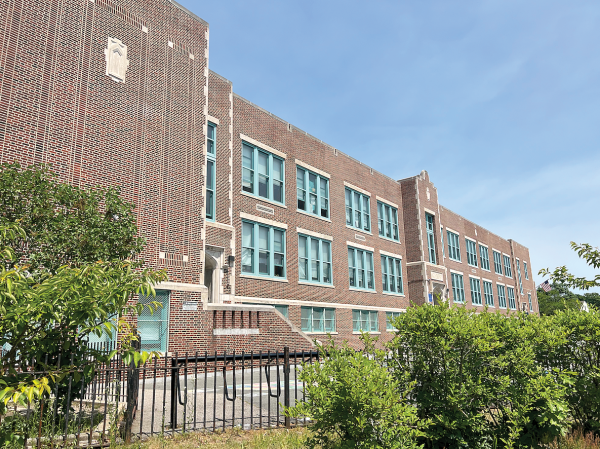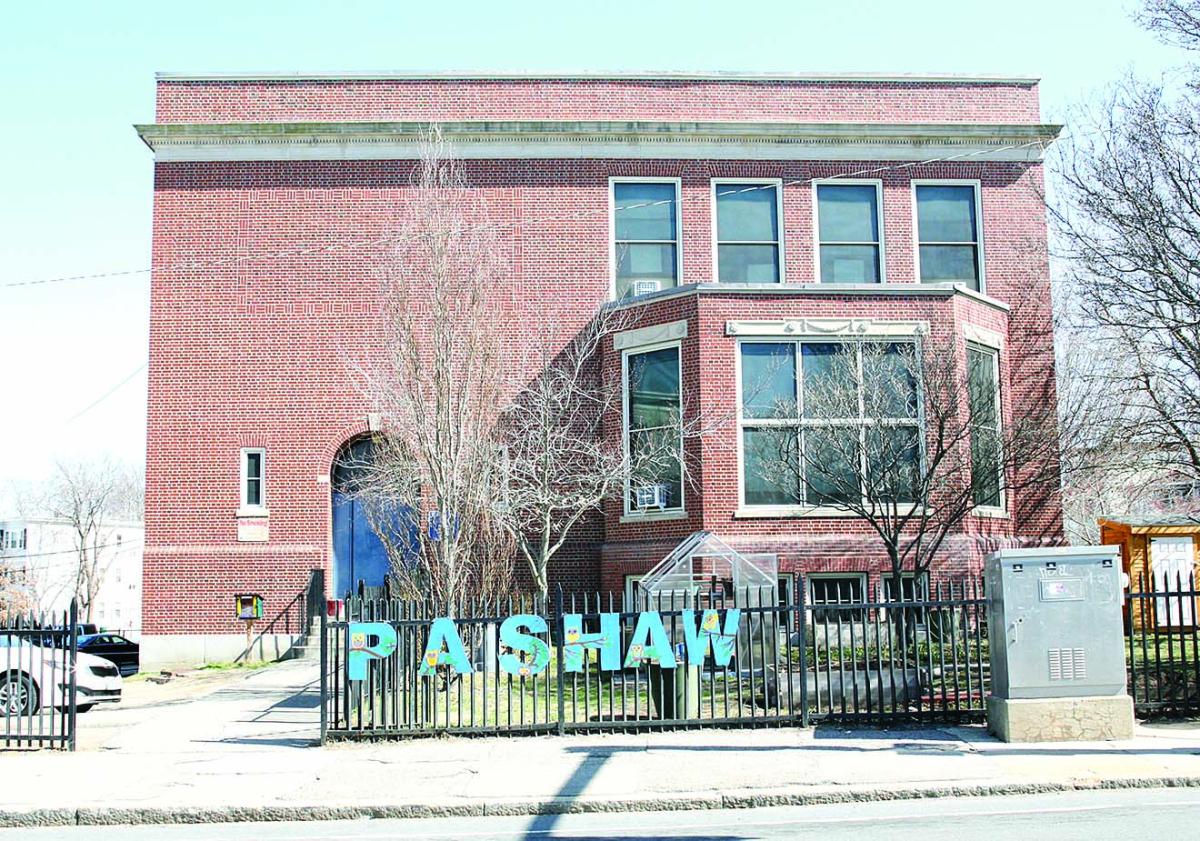May 31, 2023

The Charles H. Taylor Elementary School, above, will merge with the Pauline A. Shaw Elementary School after a May 24 vote of the Boston School Committee. The combined Shaw-Taylor school will open in the fall of 2024, serving students in grades K0 to 6. John P. Forry photo
The Boston School Committee voted last Wednesday (May 24) to approve the merger of Dorchester’s Pauline A. Shaw Elementary School with the Charles H. Taylor Elementary School in Mattapan. The schools are located off Morton Street and sit a three-minute drive apart.
The proposal passed by a 6-0 vote, with one member, Rafaela Polanco Garcia, absent.
The Shaw-Taylor was one of two mergers approved that day, and Boston Public Schools (BPS) district officials said more will follow. “Combining and reconfiguring schools is, frankly, an essential strategy to address some of the district’s long-standing challenges,” Superintendent Mary Skipper said at the May 24 meeting.
Among the BPS challenges are staffing shortages, outdated school buildings, and declining enrollment.
Critics of the merger include city councillors, who passed a resolution asking for full transparency and better community engagement from the district in their efforts to close and merge schools, and The Build BPS/Green New Deal Coalition.
Barbara Fields, a retired Boston Public School administrator and a member of the coalition, offered her view of the decision at the meeting: “This proposal does nothing to improve the education for students at the Shaw school. This is a racist policy.”
In the years to come, the district will be looking to merge more single-strand schools like the Shaw. “We’re looking really hard at single-strand schools,” Skipper said, referring to schools that only have general education classrooms, and do not have inclusion classrooms.
The combined Shaw-Taylor school will open in the fall of 2024, serving students in grades K0 to 6, a grade configuration that aligns with the district’s goal to transition to a PK to 6 / 7 to 12 model.
District officials have not explained why the Shaw and the Taylor will be the first schools to merge, but during last Wednesday’s meeting, Delavern Stanislaus, BPS chief of capital planning, said the district needed to start somewhere.
The school will be split between the current Shaw and Taylor buildings, according to the merger terms. Lower grades will be housed in the Shaw and upper grades in the Taylor.
In April, district officials submitted a statement of interest to the Massachusetts School Building Authority (MSBA) as a first step in the process of securing state funding for a new Shaw-Taylor building.
If the district receives funding from the competitive MSBA core program, the new elementary school would be projected to open in the fall of 2029, said Brian McLaughlin, project manager for the Boston public facilities department, at a March school committee meeting.
A leader has not been hired for the combined Shaw-Taylor school. Because it will be split across two campuses, Superintendent Mary Skipper said, the school may have multiple leaders.
Brandon Cardet-Hernandez, a School Committee member, pushed district officials to act quickly to identify a principal. “I choose my own child’s school based on the leadership of that school,” Cardet-Hernandez said. “I just recognize as a parent, and as a former principal myself, that people make decisions based on you.”
Skipper said the district needed to weigh the desire to announce a principal swiftly against hiring timelines, suggesting that the district may extend the search for a school leader beyond the current Shaw-Taylor community.
School panel chair says mergers long overdue
Jeri Robinson, the School Committee’s chair and a Dorchester resident, emphasized the need for consolidating schools while acknowledging that it is not easy work. “As we thank the schools who have been the guinea pigs in this, we know that mistakes have been made, and that there is a lot of work we’re going to need to do,” Robinson said, who added that merging schools was long overdue. “We have been kicking this can down the road for years,” she said.
Other committee members raised concerns about how the merger process the worked. Lorena Lopera questioned the district’s approach to community engagement. “We can continue to ask the community what they want, but then if we’re going to go back and say, ‘but we’re going to do it this way,’ I think that erodes some of the trust that we know we’re trying to build,” she said.
For his part, Cardet-Hernandez asked for more clarity. “That is not a healthy precedent, as we’re talking about multiple mergers to be like, we’ll figure it out as we go,” he said.
Another committee member, Stephen Alkins, asked about school improvements for the current Shaw-Taylor students, who will likely not see the benefits of a new building. “We know that it’s going to take time for new buildings to be constructed, so we want to make sure that their facilities and their resources are guaranteed throughout this. Whether that’s financial or that’s psychological, social supports are needed to support the community through this disruption,” Alkins said.

The PA Shaw school is a single-strand school (meaning it only has general education classrooms and no inclusion classrooms) limited to grades K-3 and having fewer than 200 students.
Reporter file photo
Shaw and Taylor teachers respond
Two teachers from the Taylor school spoke during a public comment period about the needs of their students. The Taylor and the Shaw need the same resources that schools in all small suburban, predominantly white, neighborhoods receive,” said Taylor K2 inclusion teacher Rhesa Cumberbatch. “I definitely hope that that is being brought into consideration as you guys make this merger.”
Kristin Leslie, the Taylor art teacher, asked the committee to maintain a sense of urgency to improve her students’ school experiences. “You’re only in fifth grade once. You’re only in first grade once,” she said. “I did see that all plans do have quite a while where students would be in the bigger classes but in the same dilapidated facilities.”
Leslie said her students wanted the district to provide better facilities, supplies, and opportunities for accelerated learning and sports.
Neither teacher shared an opinion about the merger itself.
In contrast to earlier meetings, Shaw families, educators, and students did not speak during public comment time.
In a phone call, Shaw K2 teacher Carla Johnson said that she didn’t show up to comment because it felt to her as if the district and the school committee had already decided to merge the two schools.
For her, the vote brought a mix of hope and grief.
“For those of us who were really fighting to keep the Shaw the Shaw, it just feels like we’re going to be swallowed up into a bigger school,” Johnson said. “I hope that’s not the case because the community that we’ve created is really strong and powerful and beautiful. “
The district says mergers are necessary
The district has 8,000 fewer students today than it did in 2013, according to the merger planning. However, it has not reduced its capacity for students. Reducing seat capacity by consolidating classrooms is important, district officials say, because staffing shortages have led to classrooms led by long-term substitutes or teachers without the appropriate licensure. As consolidation goes on, the district will need fewer teachers, allowing them to more easily fill those positions with licensed educators. Fewer teachers also saves money.
In Boston, most schools get the majority of their funding through a “weighted student formula” which allocates money according to the number of students district officials have decided should equal a fully enrolled classroom.
When a school has fewer students than is expected, the district will allocate less money for it. Less money would make it difficult – if not impossible – to meet basic budgetary needs like paying teachers, so the district provides “soft-landing” funding to make up the gap.
Three-quarters of Boston schools received “soft-landing” funding in fiscal year 2022, according to the district budget. In the 2022-23 school year, soft landing accounted for about $350,000 of the Shaw and Taylor budgets combined.
Merging the Shaw and the Taylor will save roughly $300,000 each year, according to the BPS proposal. That would leave a roughly $50,000 gap in funding. Nonetheless, district officials have committed to reinvesting this money into the Shaw-Taylor community.
Cardet-Hernandez raised questions about the reinvestment. “We are having a separate conversation during the budget cycle about clawing back funds, potentially in the next year,” he said. “What’s the length that we’re making this commitment to the community for? And what can they count on?”
Despite the impending end of pandemic-era federal funding, Nate Kuder, BPS’s chief financial officer, said the merger wasn’t about the budget. “We’re not looking to sort of use this as a way to save money. This is an opportunity for us to strengthen the school community. The biggest thing here is for us to think about is: What is the right model for the school.”
What about the required Racial Equity Planning Tool?
The Build BPS/Green New Deal Coalition published its own completed Racial Equity Planning Tool (REPT) for the Shaw-Taylor merger in the absence of one published by the district, which is required to
The district is required to complete a REPT when making any major decisions, but an internal memo from Sept. 30 revealed that the REPT had not been “authentically used” by the district on the decision to merge the Shaw and the Taylor.
At the May 14 meeting, Charles Grandson, the district’s chief equity officer, said a completed REPT was coming. “There’s a commitment to publish the results of the equity analysis in the coming weeks,” he said, explaining that it will be housed on the district’s REPT dashboard when it is launched.
This article was reported and produced in partnership with the Boston Institute for Nonprofit Journalism. The author, Emily Piper-Vallillo, is a writer and researcher who holds an M.Ed from the Harvard Graduate School of Education.



